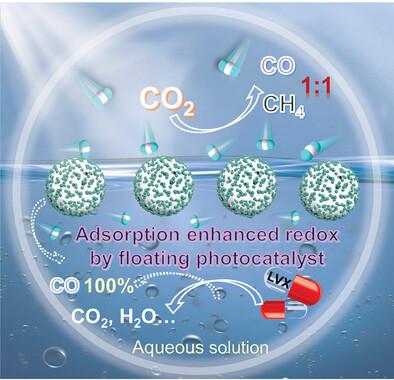当前位置:
X-MOL 学术
›
Adv. Funct. Mater.
›
论文详情
Our official English website, www.x-mol.net, welcomes your feedback! (Note: you will need to create a separate account there.)
Self-Floating Polymer Microreactor for High-Efficiency Synergistic CO2 Photoreduction and Antibiotic Degradation in One Photoredox Cycle
Advanced Functional Materials ( IF 18.5 ) Pub Date : 2024-07-01 , DOI: 10.1002/adfm.202408831 Mengmeng Wang 1 , Yingxue Zhang 1 , Shihong Dong 2 , Najun Li 1 , Qingfeng Xu 1 , Hua Li 1 , Jianmei Lu 1 , Dongyun Chen 1
Advanced Functional Materials ( IF 18.5 ) Pub Date : 2024-07-01 , DOI: 10.1002/adfm.202408831 Mengmeng Wang 1 , Yingxue Zhang 1 , Shihong Dong 2 , Najun Li 1 , Qingfeng Xu 1 , Hua Li 1 , Jianmei Lu 1 , Dongyun Chen 1
Affiliation

|
Constructing a novel photocatalyst to realize both pollutant oxidation and evolved CO2 reduction in one photoredox cycle can significantly reframe the role of pollutant management. Here, self-floating poly(bismaleimide-co-divinylbenzene) porous microspheres (PBMs) are filled with ZnSnO3 quantum dots (ZSO QDs) to construct a polymer composite microreactor with an S-scheme heterojunction (ZSO QDs/AP-PBMs). This microreactor realizes efficient catalytic oxidation and degradation of antibiotic pollutants under light, and the CO2 generated in this process is reduced to high value-added CO, allowing for the direct conversion of pollutants to a resource in one photoredox cycle. The high specific surface area of the PBMs enables the rapid and efficient adsorption of levofloxacin (LVX), and the self-floating porous design effectively solves the problem of CO2 adsorption and mass transfer in the gas–liquid–solid three-phase system, while the S-scheme heterostructure enhances charge carrier separation. As a result, ZSO QDs/AP-PBMs achieves complete degradation of LVX in one redox cycle with 100% selectivity to produce 100.3 µmol g−1 CO, and further draw a conclusion that fluoroquinones antibiotics as excellent electron donors can significantly enhance co-catalytic effect with CO2, which is not previously reported. Theoretical calculations and characterization experiments provide information on S-scheme heterojunction transfer mechanism and possible degradation pathways, allowing for the rational design of photoredox bifunctional catalysts.
中文翻译:

自漂浮聚合物微反应器可在一个光氧化还原循环中高效协同 CO2 光还原和抗生素降解
构建一种新型光催化剂,在一个光氧化还原循环中实现污染物氧化和CO 2 还原,可以显着重塑污染物管理的作用。这里,自浮式聚(双马来酰亚胺-共-二乙烯基苯)多孔微球(PBM)填充ZnSnO 3 量子点(ZSO QD),构建具有S型异质结(ZSO QD)的聚合物复合微反应器/AP-PBM)。该微反应器实现了光下抗生素污染物的高效催化氧化降解,且该过程中产生的CO 2 被还原为高附加值的CO,实现了污染物在一次光氧化还原中直接转化为资源循环。 PBM的高比表面积能够快速高效地吸附左氧氟沙星(LVX),自浮式多孔设计有效解决了气液循环中CO 2 的吸附和传质问题。固体三相体系,而S型异质结构增强了载流子分离。结果,ZSO QDs/AP-PBMs在一个氧化还原循环中实现了LVX的完全降解,选择性为100%,产生100.3 µmol g −1 CO,并进一步得出结论:氟醌类抗生素作为优异的电子供体可以显着增强与CO 2 的共催化效果,这是以前未报道过的。理论计算和表征实验提供了有关S型异质结转移机制和可能的降解途径的信息,从而可以合理设计光氧化还原双功能催化剂。
更新日期:2024-07-01
中文翻译:

自漂浮聚合物微反应器可在一个光氧化还原循环中高效协同 CO2 光还原和抗生素降解
构建一种新型光催化剂,在一个光氧化还原循环中实现污染物氧化和CO 2 还原,可以显着重塑污染物管理的作用。这里,自浮式聚(双马来酰亚胺-共-二乙烯基苯)多孔微球(PBM)填充ZnSnO 3 量子点(ZSO QD),构建具有S型异质结(ZSO QD)的聚合物复合微反应器/AP-PBM)。该微反应器实现了光下抗生素污染物的高效催化氧化降解,且该过程中产生的CO 2 被还原为高附加值的CO,实现了污染物在一次光氧化还原中直接转化为资源循环。 PBM的高比表面积能够快速高效地吸附左氧氟沙星(LVX),自浮式多孔设计有效解决了气液循环中CO 2 的吸附和传质问题。固体三相体系,而S型异质结构增强了载流子分离。结果,ZSO QDs/AP-PBMs在一个氧化还原循环中实现了LVX的完全降解,选择性为100%,产生100.3 µmol g −1 CO,并进一步得出结论:氟醌类抗生素作为优异的电子供体可以显着增强与CO 2 的共催化效果,这是以前未报道过的。理论计算和表征实验提供了有关S型异质结转移机制和可能的降解途径的信息,从而可以合理设计光氧化还原双功能催化剂。






































 京公网安备 11010802027423号
京公网安备 11010802027423号